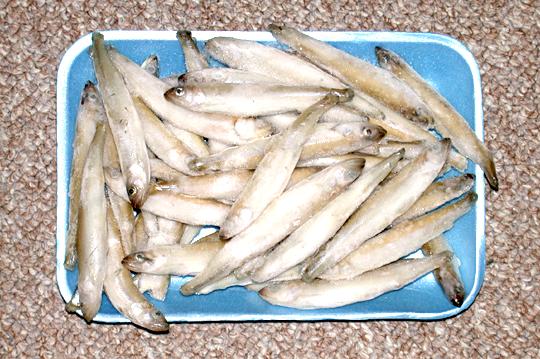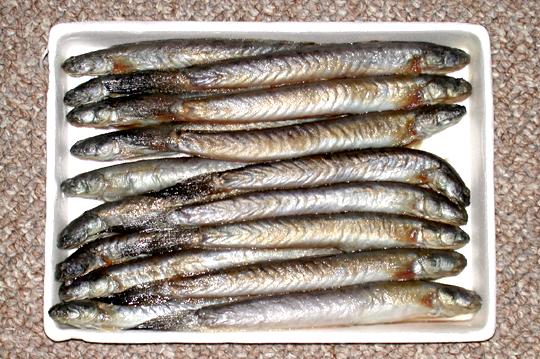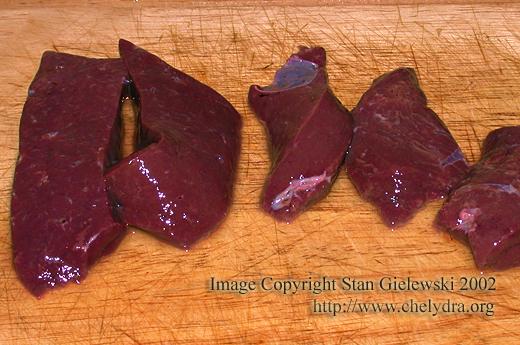Food in captivity should contain as much as passible of the diet found in the wild. Of course,
because not all of the readily in the nature available kinds of food are steadily obtainable
all year round, substitutes should be taken in consideration.
To maintain good health special attention should be paid to make sure that the diet will be well balanced. Turtles, just like any other
pet animals as dogs or cats, need all kinds of Vitamins and Minerals.
The most important are Vitamin D3, Vitamin B1 and Calcium - all needed for the healthy growth of
shell and overall strenght.
The diet of captive kept snappers should contain as much as possible of live food such as fish (gold fish,
minnows and any other small feeder fish available through the local pet store or cought
in a nearby lake or river), crayfish, frogs, snails and crickets.

If fresh food is not available there are all kinds of frozen 'goodies' out there, like smelt for example. It is a bit oily and you will have to do some cleaning after feeding.
Also the poo will be kind of greasy, but still this is a nice alternative. (bring the fish to room temperature before serving)

Another nice and cheap option is the somewhat exotic fish found at chinese stores, like the goby fish pictured below. Alongated and with lots of meat and no
fat it is a perfect meal for a turle.

Also, as an alternative, any kind of frozen fish cut to appropriate chunks is perfect for turtles of any size. Here's salmon,
readily available during the season.

A nice snack containing lots of calcium is shrimp and crayfish (live if possible). Serving shrimp a care must be taken
to make sure that all the sharp parts are cut off (I use scissors).

Next, raw lean beef, beef liver, heart (Vitamin B1), an occasional piece of squid or clam , some
vegetable matter including cabbage, fresh spinach, carrot or a banana , etc.. Because not all of
the snappers have the same taste preferances, it is good to experiment with different kinds of
food (except fatty foods like hamburgers).



Again, a care must be taken not to serve too big chungs of food and supervise the eating animal. Never throw a handful of
food in the tank and leave. It is not uncommon for a turtle to suffocate trying to swallow a chunk that is way too big.

Also chicken (preferably
cooked before serving due to reducing the risk of spreading salmonella, but not necessarily if taken from a
really fresh and clean bird. Raw chicken is actually served as food in some parts of the world, as Japan for example,
and people don't get sick. I have tried myself - sorry all the vegeterians but I'm not one of you - it tasted good and
I have never got sick nor heard of any other person getting sick).
Some snappers will also eat baby mice or a young small mouse, fully with its fur (sold usually frozen as food for snakes and lizards mainly).
A very good alternative, but some snappers will not like it (most of mine spet it out when I tried to make them eat it so I gave up on this type
of food).
In addition, a commercially available turtle food , such as Tetra Reptomin , a good
source of Vitamins, Minerals & Amino-acids) should be given to the turtles on a regular basis - but as I have said just as an addition
to their regular 'real' diet. Feeding them exclusively on commercial pallet foods will not make them strong in a long run and might lead
to some health problems later on in their lives.
It is also a good idea to enrich the turtles diet by giving them a bit of reptile vitamin supplement on
a weekly basis.It could be done by inserting a bit of the supplement in a piece of fish or a mouse before
serving.
I would like to stress that small fish, crayfish, frog, mouse etc. - should be eaten by the turtle whole, with bones, blood and internal organs.
The body fluids and solid parts of the food are needed by the turtle to produce and maintain their own balances. So, don't fillet the fish and if
the turtle is able to swallow it whole - this would be the best for it.
At times, when I can't get fish of appropriate size, I give my turtles whole fish or chicken heads (I know it sounds grousome for us but in reality
these things are being eaten in the wild and we shouldn't judge the ways of nature. Believe me, I am not different from you and I know it takes some
time before getting even used to the idea of feeding a turtle live gold fish - not mentioning a frog or a mouse!).
The hatchlings should be fed on an everyday basis, as much as they want to eat. They need constant nutrition to support their
intense shell and other body parts growth.
Mature snappers need to be fed only once in a two - three days, and later in life once a week is sufficient. The feeding
should stop when the turtles show signs of disinterest in food, such as simply taking some time
before biting onto the next piece of food. The remaining uneaten leftovers should be removed from the
tank in an hour or so after the feeding ( otherwise fouling the water ).
The turtles should be kept 'in shape' and not overfed. Kept as pets, potencially spending
their lives in aquariums, the snappers have not enough chance to exercise and burn the fat, so
it is quite easy to make them very fat. An occational walk on the grass on a sunny day
would be a good idea - also giving the snappers a chance to catch some rays necessary in producing
Vitamin D3.
For someone who would like to make his own turtle food, the recipe is as follows (after John Hoke
, Turtles and their care, cited from Pritchard, Encyclopedia of turtles):
- 2 oz. fish
- 8 oz. boiling water
- 3 oz. trout chow, ground up into a powder
- 2 oz. cod liver oil
- 1.5 oz. unflavored gelatin
- 1.5 oz. bone meal
- 1 teaspoon dibasic calcium phosphate
- 20 drops of red food coloring
Mince the fish into very small pieces. Add cod liver oil and set aside.
Dissolve unflafoured gelatin in the boiling water, stirring thoroughly.
Next, add the minced fish and oil. Then pour in the ground trout chow,
along with the bone meal and calcium. Mix well, adding twenty drops
of food coloring. Pour the mix into a shallow pie tin or plastic ice-cube
tray and put it in the refrigerator. Gel should be cut into small cubes or
stripes before feeding it to the turtles. The uneaten gel, covered with palstic
to prevent it from drying, always return to the freezer.
Have fun !
|